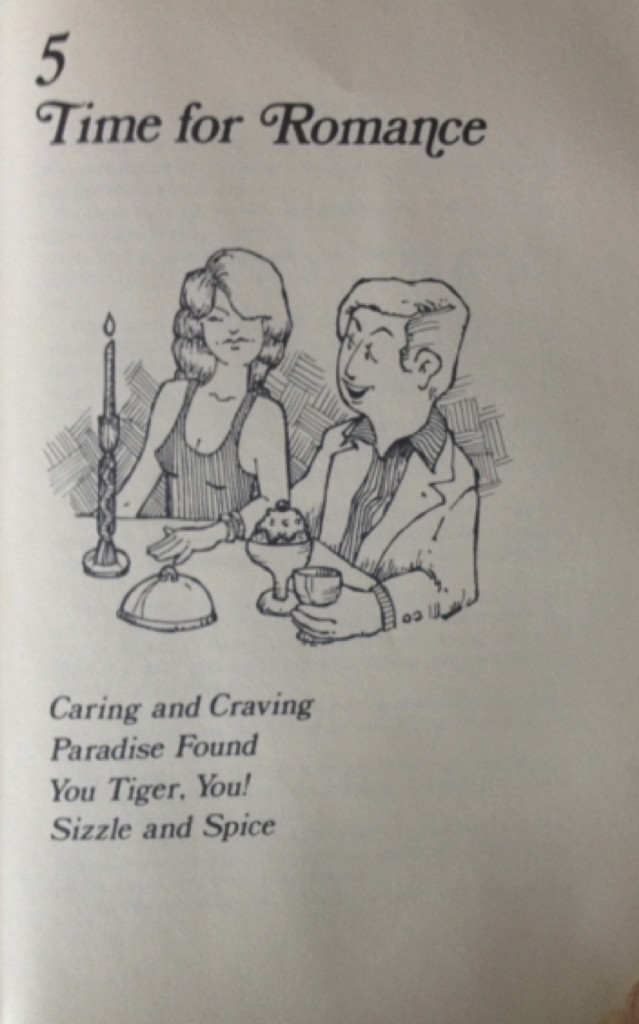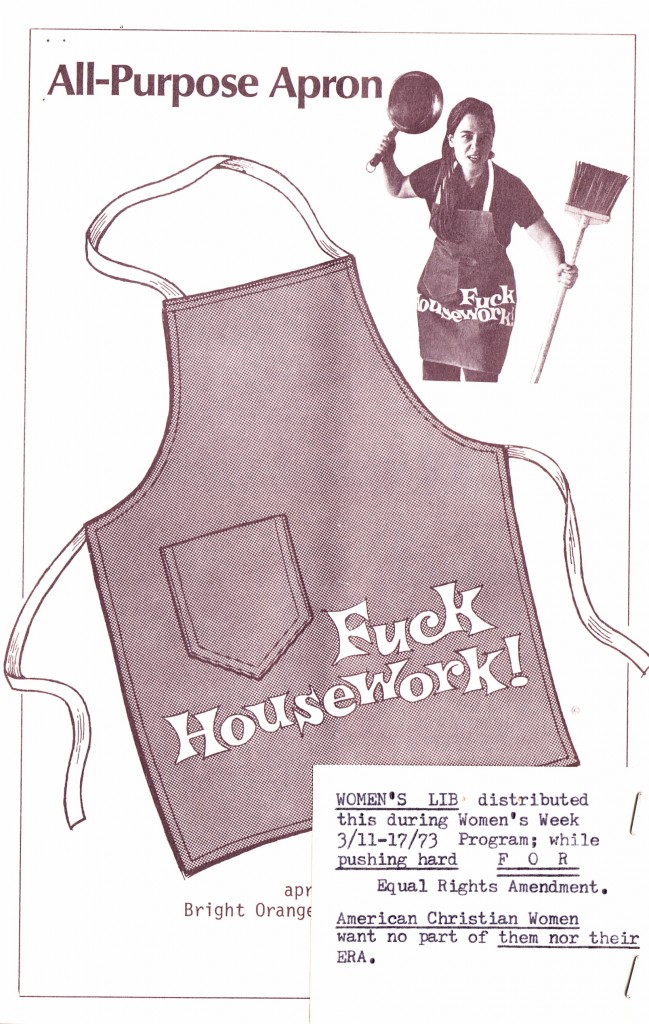Romantic dinners for lovers are one of the sweet pleasures of life, and if you don’t initiate one, who will? Remember the thrill of that special dinner before you were married? … A late intimate dinner for two beside a crackling fire, or on the back porch amid balmy breezes will help set the atmosphere.
– Marabel Morgan, The Total Woman Cookbook, 1980
What can we learn about the history of sexuality from the ways that food has been prepared, consumed and represented? Recently, I rediscovered Marabel Morgan’s Total Woman Cookbook (1980) and with it another angle of vision into the histories of sexuality and gender in the 1970s. During that decade, Morgan became the voice of a woman-led, religious-conservative ‘sexual revolution’ in the United States. As Evangelicals assumed unprecedented visibility, Morgan and a cadre of born-again women contributed to the sexualization of American culture as the authors and devotees of best-selling instruction manuals that sought to eroticize the home as a means of saving unhappy marriages. Their discussions of food and their cookbooks mapped women’s overlapping roles as wives, lovers and mothers. When Morgan approvingly told the story of a Southern Baptist woman who “welcomed her husband home in black mesh stockings, high heels, and an apron,” she yoked together traditional images of wives as cooks and homemakers with sexual scripts drawn from an increasingly pornographic culture. Morgan’s genius was that she sexualized housewives and domesticated the sexual revolution, channeling it toward conservative ends.

As she tells the story, Morgan was a born-again housewife living in the suburbs of Miami, Florida who was miserable in her marriage. She found domestic joy when she embraced scriptural guidelines and began accepting, admiring, appreciating and adapting to her husband. Her first book, The Total Woman (1973), shared these strategies for saving her own marriage and likewise promised her readers marital stability and satisfaction. Against the backdrop of rising divorce rates, second wave feminist critiques of marriage and housework, and rapidly shifting gender roles, The Total Woman quickly climbed the New York Times bestsellers list and also spent over two years on the National Religious Bestsellers list. By 1975, more than fifteen thousand women had signed up for Morgan’s “Total Woman” classes, including future antigay crusader Anita Bryant and the wives of football players on the Miami Dolphins and Green Bay Packers. By 1977, Morgan had been profiled on numerous media outlets and appeared on the cover of Time magazine. Over the course of the decade, Morgan’s devotees flooded her with correspondence and shared stories about their lives and also their recipes, some of which made it into her cookbook.
In numerous advice books throughout the 1970s, Evangelical women promoted an eroticized version of patriarchal marriage and endorsed a wide range of non-procreative sexual activities for the purposes of mutual, but mostly male, pleasure. Morgan suggested a variety of locations for intimacy ranging from the bedroom to under the dining room table. And her classes and books included sexual assignments that emphasized pleasing men, advising women to “be prepared for sexual intercourse every night for a week.” Morgan’s readers also learned that sex should be more than missionary: seductive costumes, midday phone sex and, above all, erotic spontaneity were on the menu.
Despite their books’ explicit eroticism, Evangelical authors disavowed that their marriage advice was tawdry. Citing the biblical passage from Hebrews that stated, “Marriage is honorable in all, and the bed undefiled,” conservative women legitimized non-procreative sexual pleasure. Darien Cooper, author of the popular book with the telling title You Can Be the Wife of a Happy Husband (1974), helped her readers understand that, “there are no sexual perversions when a wife is satisfying her husband’s sexual desires and needs.” Morgan used a food metaphor to convey a similar message. Sex, she wrote, is something “as clean and pure as eating cottage cheese.”
Evangelicals’ prescription for sexual activity and variety dovetailed with mainstream literature such as Dr. Alex Comfort’s 1972 bestseller, The Joy of Sex: A Gourmet Guide to Lovemaking. Comfort modeled his own work on The Joy of Cooking and organized the Joy of Sex like a cookbook with contents divided into “Starters,” “Main Courses,” and “Sauces and Pickles.” “A cookery book is an unanxious account of available dishes—culinary fantasies as well as staple dishes,” Comfort explained in one interview. “And I wanted to write an unanxious account of the full repertoire of human heterosexuality.” Morgan likewise emphasized sexual variety but spotlighted its importance in the service of gender hierarchy. Women learned from these books that an ideal “God ordained” marriage was based on wifely submission. They strived to internalize a passage from Ephesians that instructed them to “submit yourselves unto your own husbands, as unto the Lord.” “God Planned for woman to be under her husband’s rule,” wrote Morgan to her readers. At a time when the women’s movement drew attention to the politics of housework, Morgan’s cookbook prescribed and naturalized women’s roles as submissive homemakers and men as breadwinners and heads of households. Her books viewed sex as a key ingredient that transformed hierarchical and often difficult relationships into sites of pleasure and intimacy. In an intentional contrast to feminists Morgan’s books imagined cooking not as a domestic chore, but a form of foreplay and a means of seduction.

If some feminists produced aprons emblazoned with the slogan “Fuck Housework!” to express their views on gendered divisions of labor, conservative Evangelicals eroticized these divisions. Anchored in domesticity, Evangelical prescriptive literature organized sexual scenarios and culinary intimacy around the cycle of men’s workdays. Women were expected to create a romantic and sexual atmosphere starting from the first meal of the day and ending after dinner. “Set the mood for love at breakfast” with candlelight, Morgan advised in The Total Woman Cookbook. Mostly, these books offered a script in which housewives greeted husbands at the door when they came come from work. Lou Beardsley and Toni Spry, charismatic Bible study leaders who regularly addressed women’s church groups in the 1970s, offered the following marital advice in their 1975 book The Fulfilled Woman. They explained, “pleasing your husband is a full-time job and sex is part of it….Run into his arms the moment he comes home to you. Show him how pleased you are that he’s home again.” And, of course, have dinner ready. Far from sandwiches made with wonder bread, recipes emphasized culinary variety to accompany sexual variety. Morgan’s cookbook contained dishes ranging from “Boudoir Cheese Cake” to “Fantasy Rice,” which were filed under the subheading “Caring and Craving.” Other subheadings included “Paradise Found” and “Sizzle and Spice.”
Morgan invited her readers to imagine food preparation and sexual availability as intertwined forms of domestic and emotional pleasure—not religious duties or labor—to be undertaken by women. “At the end of a long day, your husband especially needs your compliments,” Morgan recommended. She continued, “Fill up his tummy with food; soothe away his frustrations with sex.” Thus, Morgan’s Total Woman Cookbook, which reiterated the themes of The Total Woman, offered a chapter entitled “Time for Romance,” in which she related how she was determined to make her husband’s “homecoming that evening extra special.” She wrote:
I bought a roast and scurried around the kitchen preparing a fancy dinner. At 4:30, I took a bubble bath, and then, on a whim, put on pink baby-doll pajamas and white boots to greet him at the front door.
Weary from the chariot race home on the expressway, my unsuspecting husband took one look at me and lost his balance on the front step.
But he must have liked what he saw. That night the Morgan household was transformed from Dullsville to Funsville—blue to red. The beginnings of romance.
Morgan worked from the truism that “the way to a man’s heart is through his stomach,” but often that journey involved a southern detour. Fantasies about food and fantasies about sex shaped Morgan’s vision for happy marriages and acted as transformative agents.
Romantic meals represented the promise of intimacy and mutual arousal. With the mood set by candlelight, flowers and food, “dinner may have to wait,” Morgan playfully warned. And indeed Total Joy—Morgan’s 1976 sequel to The Total Woman—offered the story of a Chicago housewife who served “supper in the bedroom with flowers, mild incense, Bolero on the stereo, with her in lace bikinis and black net stockings.” “We never did get to the coffee and cake,” the housewife relayed to Morgan. If food preparation was a seductive act, refrains of “he could hardly eat his dinner!” were the punch lines to stories about women’s success at eliciting men’s sexual desire through their cooking. Men were likewise meant to consume women. Morgan encouraged wives to “look and smell delicious” for their husbands. In this vein, Total Joy tells the story of a wife who made her husband a variety of green dishes to celebrate St Patrick’s Day. Transitioning seamlessly from the dishes she prepared to her own preparation, the woman wrote: “I wonder whether green Magic Marker shamrocks will wipe off certain body areas easily.”

While these examples may seem risqué, they represented the efforts of conservative religious women to shore up the institution of marriage—and their traditional position of authority as wives—by integrating emergent standards of sexual pleasure and sexual variety into Christian marriages, which emphasized women’s roles as providers of emotional, sexual and culinary nourishment. Through cookbooks and discussions of food, Morgan and her fellow authors adopted mainstream sexual mores even as they produced a distinctively Christian, conservative sexual subculture. In a decade that gave readers cookbooks that expressed a range of sexual and gender possibilities—consider the varied identities cultivated by the Fanny Hill’s Cook Book (1970), Lover’s Cookbook (1971), and The Naked Chef: A Survival Plan for the Single Man (1978)—Evangelicals actively connected their appetite for culinary and sexual variety to desires for marital intimacy and stability. In the midst of unsettling cultural shifts, this linkage of food and pleasurable sex drew from ideas so common and unremarkable that they could be packaged and sold en masse to conservative women as common sense. Equal parts prescriptive and descriptive, these cookbooks indexed recipes as well as the social changes that transformed the meanings of sexuality and domesticity in the 1970s.
 Gillian Frank is a Managing Editor of Notches: (re)marks on the history of sexuality. He is also a Visiting Fellow at Center for the Study of Religion and a lecturer in the Department of Religion at Princeton University. Gillian’s research focuses on the intersections of sexuality, race, gender and religion in the twentieth-century United States. Gillian tweets from @1gillianfrank1
Gillian Frank is a Managing Editor of Notches: (re)marks on the history of sexuality. He is also a Visiting Fellow at Center for the Study of Religion and a lecturer in the Department of Religion at Princeton University. Gillian’s research focuses on the intersections of sexuality, race, gender and religion in the twentieth-century United States. Gillian tweets from @1gillianfrank1

NOTCHES: (re)marks on the history of sexuality is licensed under a Creative Commons Attribution-NonCommercial-NoDerivatives 4.0 International License.
Based on a work at www.notchesblog.com.
For permission to publish any NOTCHES post in whole or in part please contact the editors at NotchesBlog@gmail.com





Reblogged this on firseudchala.
My favorite of this genre of marriage advice books is called “Sex Begins in the Kitchen.” It doesn’t actually have any recipes in it, though. But the kitchen is central to understanding what goes into a true marriage.